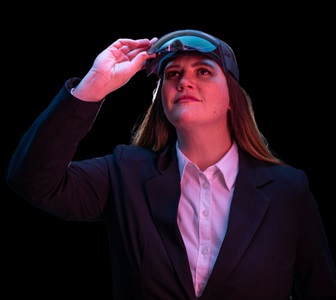Systems Engineer Cathy Berrouët did as the locals do when she moved to Colorado: she took up skiing.
FPA
JSS component is missing React implementation. See the developer console for more information.
By Bethany Wilson
Imagine the thrill of soaring above the Earth in a hot air balloon, feeling the gentle sway of the basket and seeing the world unfold below. Soon — thanks to an innovative app designed by Software Development Analysts Will Blizzard and Ryan Salaway and Software and Immersive Technology Manager Lucas Sanchez — the immersive experience of soaring above different landscapes in a hot air balloon will be accessible to many.
Will, Lucas and Ryan work at Northrop Grumman’s Albuquerque, New Mexico, site developing training experiences and programs using virtual reality (VR) and 3D simulations. Every October, the New Mexico skies above the team’s Northrop Grumman site are dotted with hot air balloons during the Albuquerque Balloon Fiesta, the world’s largest annual hot air balloon festival. This event attracts people from around the globe; however, not everyone can travel to New Mexico to witness it.
Inspired by the idea of bringing the Balloon Fiesta experience to everyone, Lucas, who was previously on faculty at Santa Fe University of Art and Design, approached Will with the idea to create a hot air balloon VR experience using their expertise and passion in their spare time. Will has one of the most unique pilot licenses in the world — one that lets him operate a hot air balloon.
“There are 500 to 600 balloons that fly on a given morning, so we talked about giving people that experience without having to travel here,” said Will, who is commercially certified by the Federal Aviation Administration.
The team took a hands-on approach, first embarking on hot air balloon flights to capture photographs from multiple angles, ensuring they could recreate the experience faithfully. Not only did they pay attention to the balloon itself but also they photographed the basket, a critical part of flight, to capture the high fidelity of its structure.
“We’ve done a lot of simulations for different programs, creating and capturing the fidelity of being somewhere, like in an aircraft,” said Lucas. “The more lifelike we make a simulation, the more immersive it feels, which engages people on an emotional level. There’s something really special about the power of providing that opportunity for a user to emotionally connect to an experience.”
The app’s most important aspect is the world around the balloon. To create this, the team uses satellite data from Google, which provides accurate, detailed maps of the scenery. This data is crucial in constructing a realistic, immersive environment that users can explore from their virtual balloon ride.
“We build things like trees, buildings, brush, the mountain range, and get them built into VR and then see how this digital world looks. We’re looking to ensure the scale is appropriate and I’m getting that wonder and awe of being in a hot air balloon,” said Ryan.
While the app — which they’re calling “Balloon Rider” — is still in development, the team has made significant progress since starting last year. This project is more than just a technical challenge; it’s about creating an experience that resonates on a deeply personal level. “Balloon Rider” will be a testament to the power technology has in bringing experiences to those who might otherwise never have them. By combining their expertise in simulations with a passion for wanting to create an emotional and accessible experience, the team is well on their way to delivering an app that is truly uplifting.
Life at Northrop Grumman
Your work at Northrop Grumman makes a difference. Whether you want to design next-generation aircraft, harness digital technologies or build spacecraft that will return humanity to the moon, you’ll contribute to technology that’s transforming the world. Check out our career opportunities to see how you can help define possible.


